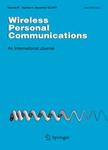版权所有:内蒙古大学图书馆 技术提供:维普资讯• 智图
内蒙古自治区呼和浩特市赛罕区大学西街235号 邮编: 010021

作者机构:Univ Teknol PETRONAS CIS Dept Tronoh Perak Malaysia Univ Teknol PETRONAS FAS Dept Tronoh Perak Malaysia Gordon Coll Dept Comp Sci Rawalpindi Pakistan Univ Teknol PETRONAS Tronoh Perak Malaysia
出 版 物:《WIRELESS PERSONAL COMMUNICATIONS》 (无线个人通信)
年 卷 期:2014年第79卷第1期
页 面:339-361页
核心收录:
学科分类:0810[工学-信息与通信工程] 0809[工学-电子科学与技术(可授工学、理学学位)] 08[工学]
基 金:Universti Teknologi PETRONAS
主 题:Propagation delays 3-D spaces Routing algorithms UWSN L2-ABF Flooding angle Horizontal communication
摘 要:Providing better communication and maximising the communication performance in a Underwater Wireless Sensor Network (UWSN) is always challenging due to the volatile characteristics of the underwater environment. Radio signals cannot properly propagate underwater, so there is a need for acoustic technology that can support better data rates and reliable underwater wireless communications. Node mobility, 3-D spaces and horizontal communication links are some critical challenges to the researcher in designing new routing protocols for UWSNs. In this paper, we have proposed a novel routing protocol called Layer by layer Angle-Based Flooding (L2-ABF) to address the issues of continuous node movements, end-to-end delays and energy consumption. In L2-ABF, every node can calculate its flooding angle to forward data packets toward the sinks without using any explicit configuration or location information. The simulation results show that L2-ABF has some advantages over some existing flooding-based techniques and also can easily manage quick routing changes where node movements are frequent.